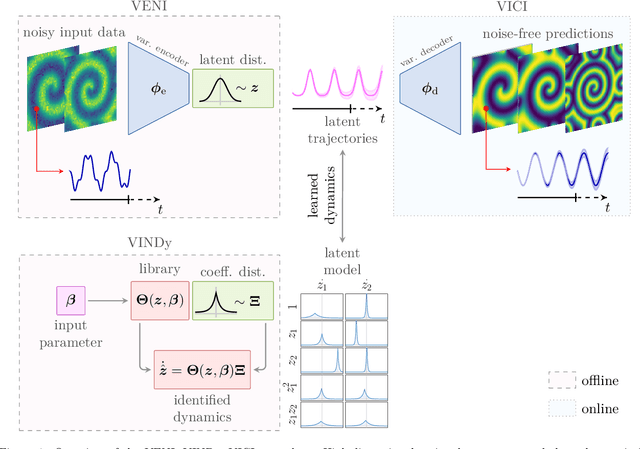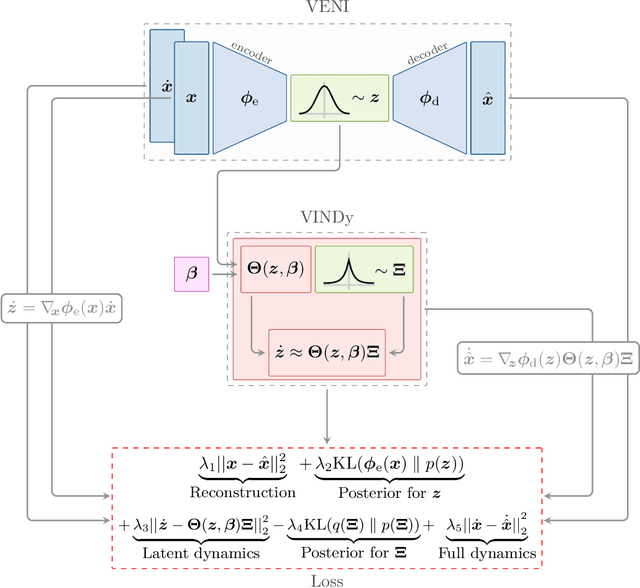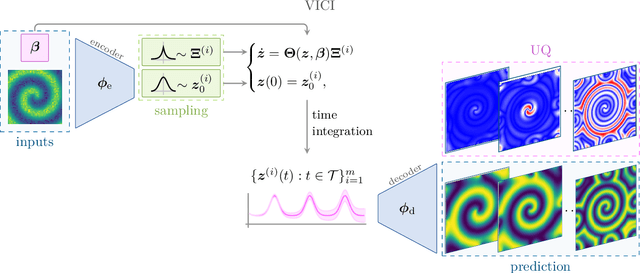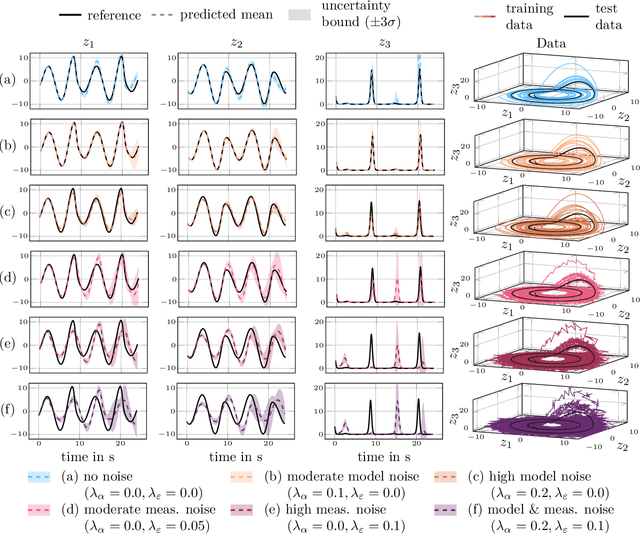Steven L. Brunton
Department of Mechanical Engineering, University of Washington
Computed tomography using meta-optics
Nov 13, 2024Abstract:Computer vision tasks require processing large amounts of data to perform image classification, segmentation, and feature extraction. Optical preprocessors can potentially reduce the number of floating point operations required by computer vision tasks, enabling low-power and low-latency operation. However, existing optical preprocessors are mostly learned and hence strongly depend on the training data, and thus lack universal applicability. In this paper, we present a metaoptic imager, which implements the Radon transform obviating the need for training the optics. High quality image reconstruction with a large compression ratio of 0.6% is presented through the use of the Simultaneous Algebraic Reconstruction Technique. Image classification with 90% accuracy is presented on an experimentally measured Radon dataset through neural network trained on digitally transformed images.
A deep learning approach to wall-shear stress quantification: From numerical training to zero-shot experimental application
Sep 05, 2024Abstract:The accurate quantification of wall-shear stress dynamics is of substantial importance for various applications in fundamental and applied research, spanning areas from human health to aircraft design and optimization. Despite significant progress in experimental measurement techniques and post-processing algorithms, temporally resolved wall-shear stress dynamics with adequate spatial resolution and within a suitable spatial domain remain an elusive goal. To address this gap, we introduce a deep learning architecture that ingests wall-parallel velocity fields from the logarithmic layer of turbulent wall-bounded flows and outputs the corresponding 2D wall-shear stress fields with identical spatial resolution and domain size. From a physical perspective, our framework acts as a surrogate model encapsulating the various mechanisms through which highly energetic outer-layer flow structures influence the governing wall-shear stress dynamics. The network is trained in a supervised fashion on a unified dataset comprising direct numerical simulations of statistically 1D turbulent channel and spatially developing turbulent boundary layer flows at friction Reynolds numbers ranging from 390 to 1,500. We demonstrate a zero-shot applicability to experimental velocity fields obtained from Particle-Image Velocimetry measurements and verify the physical accuracy of the wall-shear stress estimates with synchronized wall-shear stress measurements using the Micro-Pillar Shear-Stress Sensor for Reynolds numbers up to 2,000. In summary, the presented framework lays the groundwork for extracting inaccessible experimental wall-shear stress information from readily available velocity measurements and thus, facilitates advancements in a variety of experimental applications.
Estimating Dynamic Flow Features in Groups of Tracked Objects
Aug 29, 2024Abstract:Interpreting motion captured in image sequences is crucial for a wide range of computer vision applications. Typical estimation approaches include optical flow (OF), which approximates the apparent motion instantaneously in a scene, and multiple object tracking (MOT), which tracks the motion of subjects over time. Often, the motion of objects in a scene is governed by some underlying dynamical system which could be inferred by analyzing the motion of groups of objects. Standard motion analyses, however, are not designed to intuit flow dynamics from trajectory data, making such measurements difficult in practice. The goal of this work is to extend gradient-based dynamical systems analyses to real-world applications characterized by complex, feature-rich image sequences with imperfect tracers. The tracer trajectories are tracked using deep vision networks and gradients are approximated using Lagrangian gradient regression (LGR), a tool designed to estimate spatial gradients from sparse data. From gradients, dynamical features such as regions of coherent rotation and transport barriers are identified. The proposed approach is affordably implemented and enables advanced studies including the motion analysis of two distinct object classes in a single image sequence. Two examples of the method are presented on data sets for which standard gradient-based analyses do not apply.
VENI, VINDy, VICI: a variational reduced-order modeling framework with uncertainty quantification
May 31, 2024



Abstract:The simulation of many complex phenomena in engineering and science requires solving expensive, high-dimensional systems of partial differential equations (PDEs). To circumvent this, reduced-order models (ROMs) have been developed to speed up computations. However, when governing equations are unknown or partially known, typically ROMs lack interpretability and reliability of the predicted solutions. In this work we present a data-driven, non-intrusive framework for building ROMs where the latent variables and dynamics are identified in an interpretable manner and uncertainty is quantified. Starting from a limited amount of high-dimensional, noisy data the proposed framework constructs an efficient ROM by leveraging variational autoencoders for dimensionality reduction along with a newly introduced, variational version of sparse identification of nonlinear dynamics (SINDy), which we refer to as Variational Identification of Nonlinear Dynamics (VINDy). In detail, the method consists of Variational Encoding of Noisy Inputs (VENI) to identify the distribution of reduced coordinates. Simultaneously, we learn the distribution of the coefficients of a pre-determined set of candidate functions by VINDy. Once trained offline, the identified model can be queried for new parameter instances and new initial conditions to compute the corresponding full-time solutions. The probabilistic setup enables uncertainty quantification as the online testing consists of Variational Inference naturally providing Certainty Intervals (VICI). In this work we showcase the effectiveness of the newly proposed VINDy method in identifying interpretable and accurate dynamical system for the R\"ossler system with different noise intensities and sources. Then the performance of the overall method - named VENI, VINDy, VICI - is tested on PDE benchmarks including structural mechanics and fluid dynamics.
Opportunities for machine learning in scientific discovery
May 07, 2024Abstract:Technological advancements have substantially increased computational power and data availability, enabling the application of powerful machine-learning (ML) techniques across various fields. However, our ability to leverage ML methods for scientific discovery, {\it i.e.} to obtain fundamental and formalized knowledge about natural processes, is still in its infancy. In this review, we explore how the scientific community can increasingly leverage ML techniques to achieve scientific discoveries. We observe that the applicability and opportunity of ML depends strongly on the nature of the problem domain, and whether we have full ({\it e.g.}, turbulence), partial ({\it e.g.}, computational biochemistry), or no ({\it e.g.}, neuroscience) {\it a-priori} knowledge about the governing equations and physical properties of the system. Although challenges remain, principled use of ML is opening up new avenues for fundamental scientific discoveries. Throughout these diverse fields, there is a theme that ML is enabling researchers to embrace complexity in observational data that was previously intractable to classic analysis and numerical investigations.
SINDy-RL: Interpretable and Efficient Model-Based Reinforcement Learning
Mar 14, 2024



Abstract:Deep reinforcement learning (DRL) has shown significant promise for uncovering sophisticated control policies that interact in environments with complicated dynamics, such as stabilizing the magnetohydrodynamics of a tokamak fusion reactor or minimizing the drag force exerted on an object in a fluid flow. However, these algorithms require an abundance of training examples and may become prohibitively expensive for many applications. In addition, the reliance on deep neural networks often results in an uninterpretable, black-box policy that may be too computationally expensive to use with certain embedded systems. Recent advances in sparse dictionary learning, such as the sparse identification of nonlinear dynamics (SINDy), have shown promise for creating efficient and interpretable data-driven models in the low-data regime. In this work we introduce SINDy-RL, a unifying framework for combining SINDy and DRL to create efficient, interpretable, and trustworthy representations of the dynamics model, reward function, and control policy. We demonstrate the effectiveness of our approaches on benchmark control environments and challenging fluids problems. SINDy-RL achieves comparable performance to state-of-the-art DRL algorithms using significantly fewer interactions in the environment and results in an interpretable control policy orders of magnitude smaller than a deep neural network policy.
Koopman-Assisted Reinforcement Learning
Mar 04, 2024Abstract:The Bellman equation and its continuous form, the Hamilton-Jacobi-Bellman (HJB) equation, are ubiquitous in reinforcement learning (RL) and control theory. However, these equations quickly become intractable for systems with high-dimensional states and nonlinearity. This paper explores the connection between the data-driven Koopman operator and Markov Decision Processes (MDPs), resulting in the development of two new RL algorithms to address these limitations. We leverage Koopman operator techniques to lift a nonlinear system into new coordinates where the dynamics become approximately linear, and where HJB-based methods are more tractable. In particular, the Koopman operator is able to capture the expectation of the time evolution of the value function of a given system via linear dynamics in the lifted coordinates. By parameterizing the Koopman operator with the control actions, we construct a ``Koopman tensor'' that facilitates the estimation of the optimal value function. Then, a transformation of Bellman's framework in terms of the Koopman tensor enables us to reformulate two max-entropy RL algorithms: soft value iteration and soft actor-critic (SAC). This highly flexible framework can be used for deterministic or stochastic systems as well as for discrete or continuous-time dynamics. Finally, we show that these Koopman Assisted Reinforcement Learning (KARL) algorithms attain state-of-the-art (SOTA) performance with respect to traditional neural network-based SAC and linear quadratic regulator (LQR) baselines on four controlled dynamical systems: a linear state-space system, the Lorenz system, fluid flow past a cylinder, and a double-well potential with non-isotropic stochastic forcing.
Multi-Hierarchical Surrogate Learning for Structural Dynamical Crash Simulations Using Graph Convolutional Neural Networks
Feb 15, 2024



Abstract:Crash simulations play an essential role in improving vehicle safety, design optimization, and injury risk estimation. Unfortunately, numerical solutions of such problems using state-of-the-art high-fidelity models require significant computational effort. Conventional data-driven surrogate modeling approaches create low-dimensional embeddings for evolving the dynamics in order to circumvent this computational effort. Most approaches directly operate on high-resolution data obtained from numerical discretization, which is both costly and complicated for mapping the flow of information over large spatial distances. Furthermore, working with a fixed resolution prevents the adaptation of surrogate models to environments with variable computing capacities, different visualization resolutions, and different accuracy requirements. We thus propose a multi-hierarchical framework for structurally creating a series of surrogate models for a kart frame, which is a good proxy for industrial-relevant crash simulations, at different levels of resolution. For multiscale phenomena, macroscale features are captured on a coarse surrogate, whereas microscale effects are resolved by finer ones. The learned behavior of the individual surrogates is passed from coarse to finer levels through transfer learning. In detail, we perform a mesh simplification on the kart model to obtain multi-resolution representations of it. We then train a graph-convolutional neural network-based surrogate that learns parameter-dependent low-dimensional latent dynamics on the coarsest representation. Subsequently, another, similarly structured surrogate is trained on the residual of the first surrogate using a finer resolution. This step can be repeated multiple times. By doing so, we construct multiple surrogates for the same system with varying hardware requirements and increasing accuracy.
A Unified Framework to Enforce, Discover, and Promote Symmetry in Machine Learning
Nov 01, 2023Abstract:Symmetry is present throughout nature and continues to play an increasingly central role in physics and machine learning. Fundamental symmetries, such as Poincar\'{e} invariance, allow physical laws discovered in laboratories on Earth to be extrapolated to the farthest reaches of the universe. Symmetry is essential to achieving this extrapolatory power in machine learning applications. For example, translation invariance in image classification allows models with fewer parameters, such as convolutional neural networks, to be trained on smaller data sets and achieve state-of-the-art performance. In this paper, we provide a unifying theoretical and methodological framework for incorporating symmetry into machine learning models in three ways: 1. enforcing known symmetry when training a model; 2. discovering unknown symmetries of a given model or data set; and 3. promoting symmetry during training by learning a model that breaks symmetries within a user-specified group of candidates when there is sufficient evidence in the data. We show that these tasks can be cast within a common mathematical framework whose central object is the Lie derivative associated with fiber-linear Lie group actions on vector bundles. We extend and unify several existing results by showing that enforcing and discovering symmetry are linear-algebraic tasks that are dual with respect to the bilinear structure of the Lie derivative. We also propose a novel way to promote symmetry by introducing a class of convex regularization functions based on the Lie derivative and nuclear norm relaxation to penalize symmetry breaking during training of machine learning models. We explain how these ideas can be applied to a wide range of machine learning models including basis function regression, dynamical systems discovery, multilayer perceptrons, and neural networks acting on spatial fields such as images.
Uncovering wall-shear stress dynamics from neural-network enhanced fluid flow measurements
Oct 18, 2023Abstract:Friction drag from a turbulent fluid moving past or inside an object plays a crucial role in domains as diverse as transportation, public utility infrastructure, energy technology, and human health. As a direct measure of the shear-induced friction forces, an accurate prediction of the wall-shear stress can contribute to sustainability, conservation of resources, and carbon neutrality in civil aviation as well as enhanced medical treatment of vascular diseases and cancer. Despite such importance for our modern society, we still lack adequate experimental methods to capture the instantaneous wall-shear stress dynamics. In this contribution, we present a holistic approach that derives velocity and wall-shear stress fields with impressive spatial and temporal resolution from flow measurements using a deep optical flow estimator with physical knowledge. The validity and physical correctness of the derived flow quantities is demonstrated with synthetic and real-world experimental data covering a range of relevant fluid flows.
 Add to Chrome
Add to Chrome Add to Firefox
Add to Firefox Add to Edge
Add to Edge